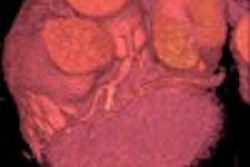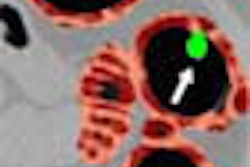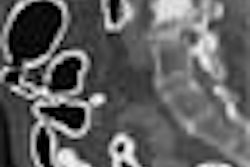CHICAGO - In the first large-scale prospective trial of its kind, Dutch researchers have found a strong association between CT-detected coronary calcium and mortality. Moreover, the association was independent of other risk factors for coronary artery disease.
In Sunday's atherosclerosis imaging sessions of the RSNA 2002 conference, Dr. Jan de Groot from Erasmus University Medical School in the Netherlands presented preliminary follow-up data gathered from participants in the Rotterdam study, a large-scale population-based study that aimed to assess the effects of coronary calcium in the elderly.
While the link between coronary artery calcification and mortality has been established in smaller studies, large-scale prospective data needed to prove the association in the general population of elderly patients has been lacking, de Groot said.
Baseline data for this arm of the 10-year study were collected between 1997 and 2000, during which 2,063 patients aged 55-85 (mean age 71) underwent coronary calcium assessment with electron-beam CT scanning, de Groot said. The entire heart was scanned in a single breathhold, with 38 slices acquired at 3-mm collimation, using ECG triggering at 80% R-R.
"We did the analysis on AccuImage software, and we defined coronary calcification as a minimum of 2 adjacent pixels at a minimum of 130 HU," he said. The calcium was scored according to the Agatston system.
Patients were followed up until death or until December 31, 2001, with a mean 2.7 years of follow-up. Eighty percent of the patients participated in follow-up. Patients were divided into relative risk groups based on their calcium scores: 0-100 (46%), 101-500 (27%), and over 500 (27%).
Cox regression analysis was used to calculate the risk of death in each of the three calcium score categories, and additional adjustments were made for other cardiovascular risk factors, such as age, smoking, cholesterol profile, etc., de Groot said.
Ninety-six subjects died during follow-up period, including 19 with calcium scores of 0-100, 32 with calcium scores of 100-500, and 45 with calcium scores over 500. The death rate rose with increases in the calcium score. Compared to subjects with calcium scores of 100 or less, those scoring 101-500 had 2.0 times the risk of death, and subjects who scored over 500 had 2.7 times the risk of death, de Groot said.
After additional adjustments for cardiovascular risk factors other than calcium, the relative risk of death was 1.6 for a calcium score of 101-500 (95% confidence index, 0.8 - 2.9), and 2.2 for scores greater than 500.
Thus, the risk of death was essentially unchanged even when patients with known cardiovascular disease were excluded from the calculations, de Groot said.
"(Compared with other risk factors) the strength of the association is higher in the highest calcium scores," de Groot said. "The predictive power of risk factors decreases with age due to the power of competing risk factors," he said, but calcium scores remain significant.
"In conclusion, we think that coronary calcification is a strong predictor of mortality in the elderly, and is independent of other cardiovascular risk factors," de Groot said.
Responding to questions following the presentation, de Groot said no attempt was made to separate all-cause mortality from cardiovascular mortality in the study population because the reasons given for cause of death are not reliable.
By Eric Barnes
AuntMinnie.com staff writer
December 1, 2002
Related Reading
Technology keeps CT vital for coronary assessment, November 13, 2002
Coronary
calcium, C-reactive protein predict cardiovascular event, October 3, 2002
High coronary calcium level predicts progression of arterial calcification, July 2, 2002
Copyright © 2002 AuntMinnie.com



















